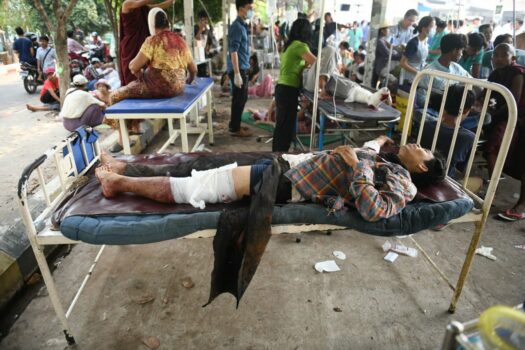 A powerful 7.7 magnitude earthquake struck Myanmar on Friday, causing extensive damage across Southeast Asia and resulting in multiple casualties. The United States Geological Survey (USGS) reported the earthquake’s epicenter was located approximately 17 kilometers from Mandalay, with a depth of 10 kilometers.
A powerful 7.7 magnitude earthquake struck Myanmar on Friday, causing extensive damage across Southeast Asia and resulting in multiple casualties. The United States Geological Survey (USGS) reported the earthquake’s epicenter was located approximately 17 kilometers from Mandalay, with a depth of 10 kilometers.
In Myanmar, the earthquake’s impact was particularly severe. At least three people died when a mosque partially collapsed in Taungoo, while local media reported two deaths and 20 injuries after a hotel crumbled in Aung Ban. The quake caused building collapses in five cities and towns, including critical infrastructure damage such as a railway bridge and a road bridge on the Yangon-Mandalay Expressway.
Thailand also experienced significant destruction, with rescuers in Bangkok searching for 81 people trapped in the rubble of a collapsed skyscraper under construction. Bangkok’s governor confirmed three deaths at the building site and warned of potential aftershocks while attempting to reassure the public.
The earthquake was followed by powerful aftershocks, leaving residents terrified. A Mandalay resident described witnessing a five-story building collapse, with people flooding into streets and refusing to return to buildings.
The disaster comes at a particularly challenging time for Myanmar, which is already struggling with internal conflicts and humanitarian crises. The country’s military government declared a state of emergency in multiple regions, though specific details of damage remain limited.
In Bangkok, the earthquake’s impact was widely felt, with office towers swaying and the Stock Exchange of Thailand suspending afternoon trading. Witnesses reported buildings creaking and parts of ceilings collapsing, causing widespread panic.
China’s Xinhua news agency reported strong tremors in southwestern Yunnan province, which borders Myanmar, though no casualties were initially reported.
Humanitarian experts, including Amnesty International’s Myanmar researcher Joe Freeman, have expressed concern about the country’s ability to respond effectively to the disaster, given its current political and economic challenges.
The earthquake adds to Myanmar’s recent string of natural disasters, including Typhoon Yagi and Cyclone Mocha, further straining the country’s already fragile infrastructure and humanitarian resources.

Trump Announces Sweeping 25% Tariffs On Imported Cars And Parts
Sensitive US Military Plans Leaked In Stunning Security Breach
Israel Resumes Strikes On Gaza, Killing Over 400 Amid Ceasefire Breakdown
Trump, Putin Agree To Limited Ceasefire In Ukraine, Wider Truce Uncertain